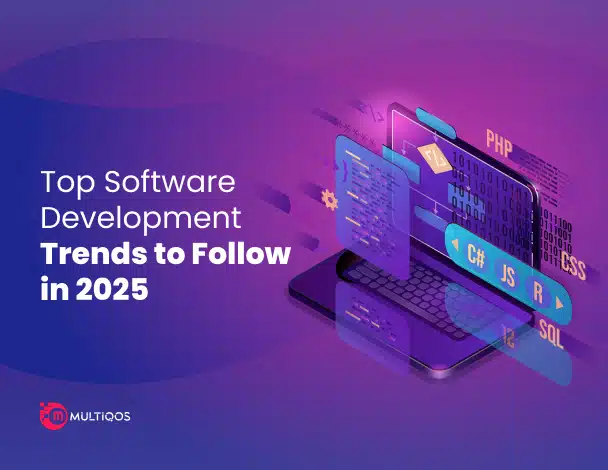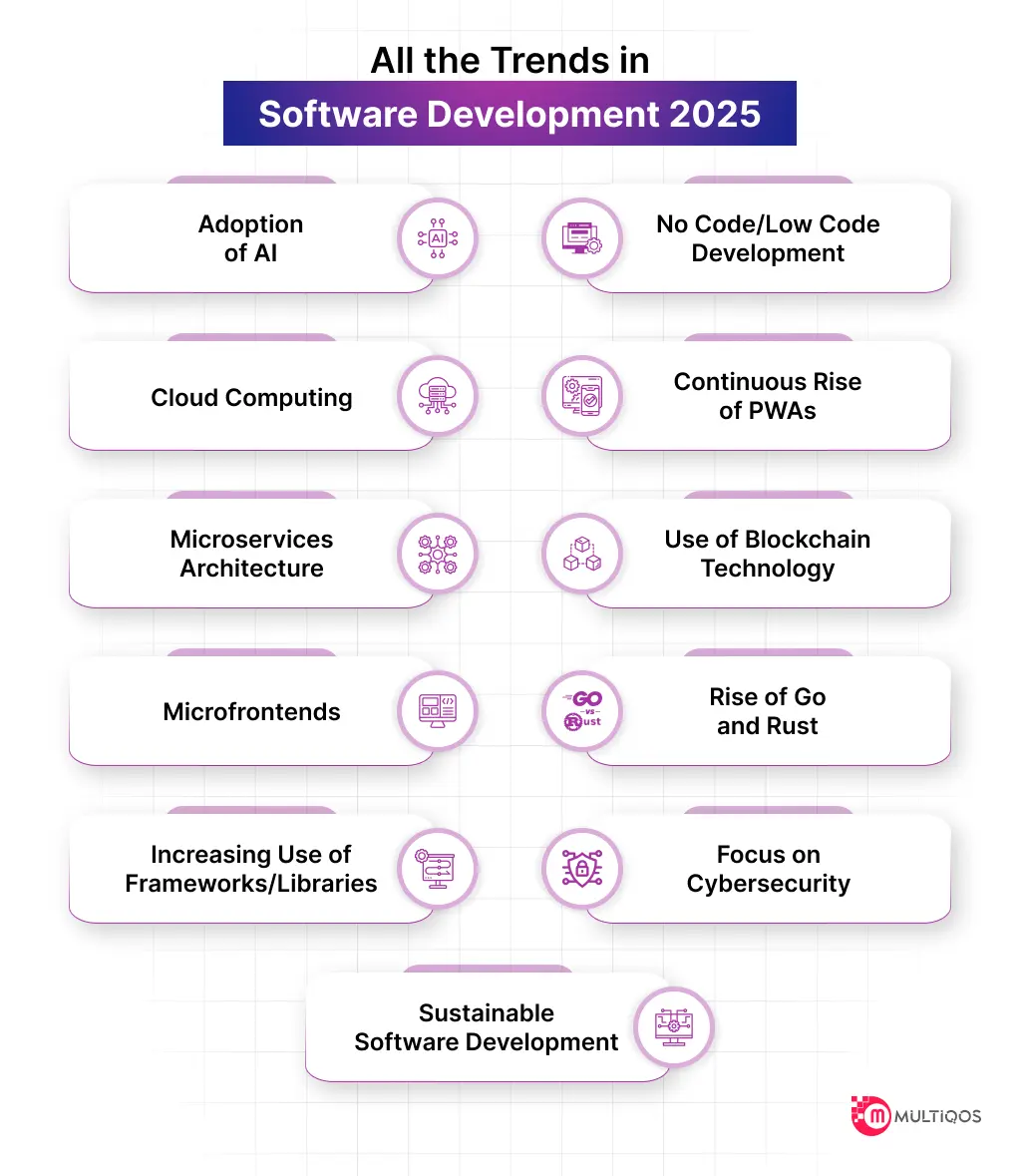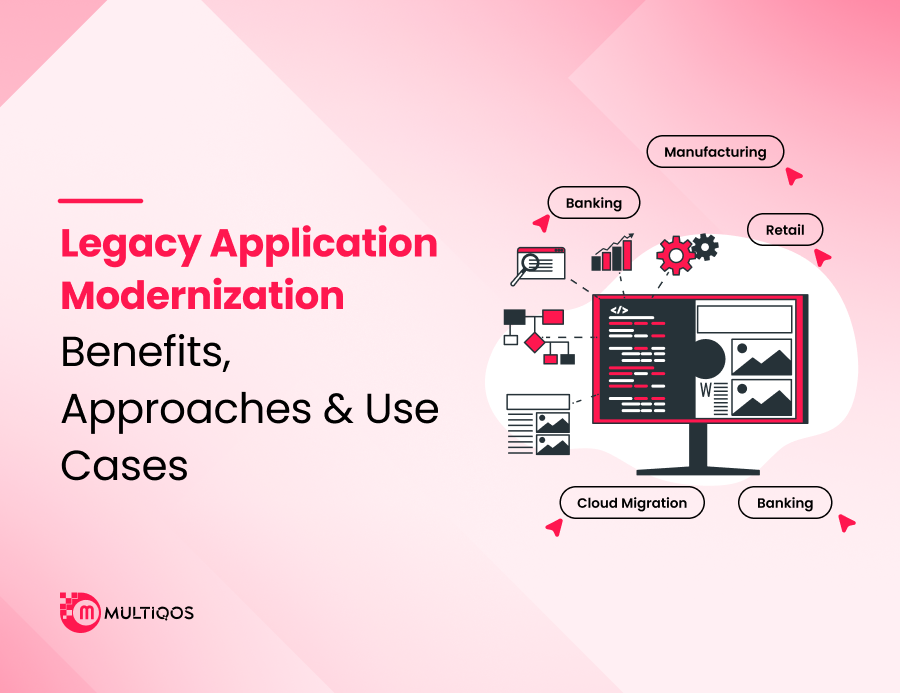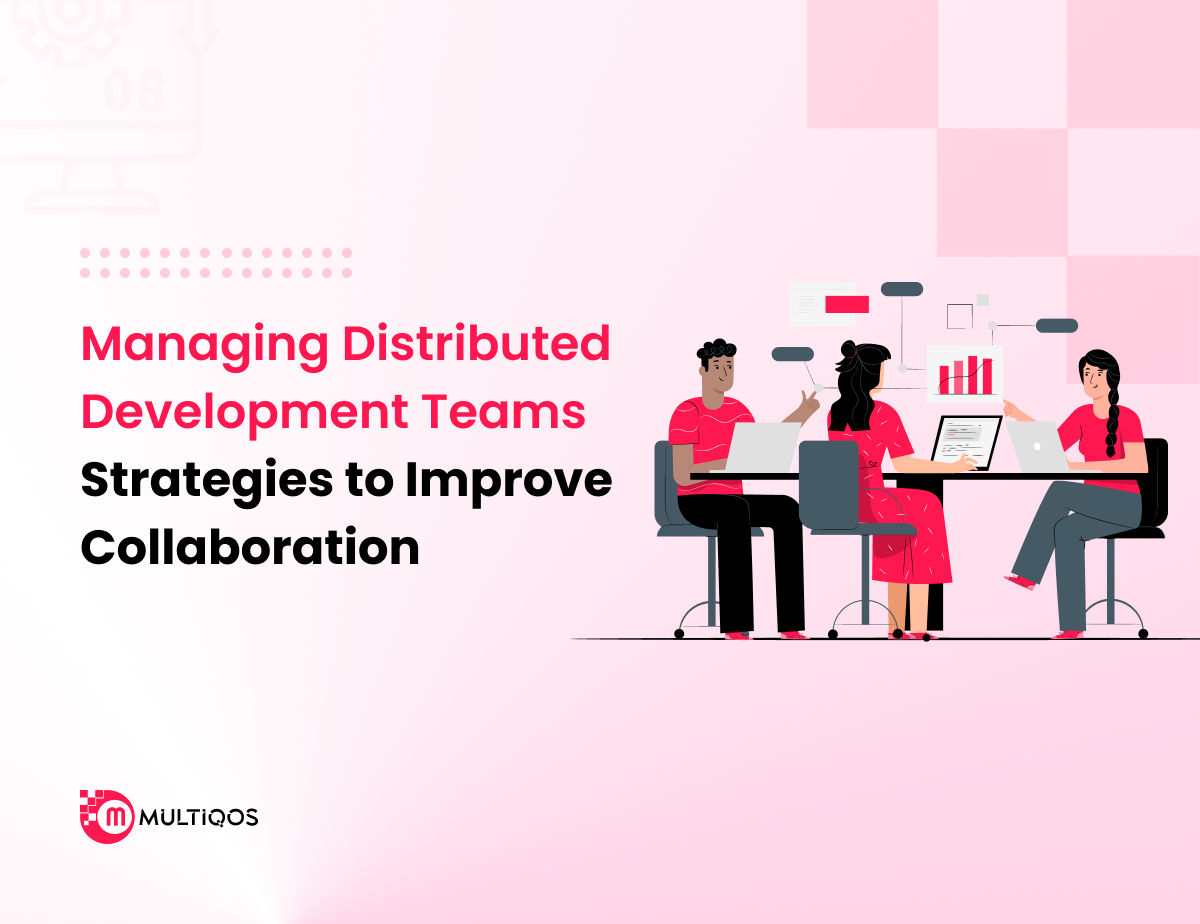Top Software Development Trends to Follow in 2025

The software development industry is taking new strides every year with new innovations and trends. As the year 2025 is just around the corner, discussions about new trends in software development for 2025 have started.
There are many software development trends in 2025 that are going to redefine this domain. These trends offer enhanced ways to develop software solutions. Integrating these trends into your software development project will help create cutting-edge solutions.
In this article, we are going to discuss top trends in software development in 2025 that you can leverage for your project.
An Overview of Software Development Trends
Software development trends are innovations or practices that are trending in the industry and bring a notable change. Trends help create solutions that keep you abreast of the latest innovations.
Trends in software development help you build software solutions that offer cutting-edge features. Plus, they also offer enhanced methods to develop software solutions. For example, Artificial Intelligence or AI is one of the biggest trends in software development.
Software developers leverage AI to automate and speed up the software development process. With the use of AI tools, developers can enhance the speed of their AI development workflow. Besides, AI can be used to improve software testing and debugging processes.
On the other hand, AI can be integrated into software to build efficient and feature-rich solutions. With AI-based features, software can become more powerful and automate tasks.
All the Trends in Software Development 2025
The following is a complete list of top trends in software development in 2025. These trends are going to redefine the future of software development.
Adoption of AI
The advent of AI (Artificial Intelligence) has revolutionized different industries including software development. AI offers numerous advantages in software development including a streamlined and faster development process. With the use of AI, developers can code faster and minimize the time needed for development.
AI-based tools help automate software testing and debugging to build quality solutions. Besides, AI tools integrate with code editors to provide real-time corrections and errors when developers code. Today, the use of AI is increasing in development environments providing efficient ways for developers to build and test software solutions.
For example, AI tools like ChatGPT, Copilot, and Tabnine streamline coding and reduce developers’ burden. These tools also automate repetitive tasks that minimize overall effort in software development.
No-Code/Low-Code Development
Software development projects often fail due to complexity and bugs. In fact, as per data, 20% of projects don’t go successful. Hence, a more robust approach to software development is required to ensure project success. The use of No-Code and Low-Code software development methods is increasing which helps create software solutions by leveraging codeless platforms.
These methods don’t require advanced coding skills and make developing software quick and convenient even for individuals with no technical knowledge. While No-Code offers a visual environment to create software without pre-coded blocks, Low-Code platforms include a bit of technical aspect.
An example of this type of platform is Bubble which is a no-code platform enabling users to create apps. No-code and low-code development has brought a new revolution in the software development industry. These new methods offer a simple and hassle-free way to make software solutions for businesses.
Cloud Computing
Cloud computing is another revolution in software development that offers a more efficient and powerful backend for applications. Cloud platforms like AWS, Azure, and Google Cloud Platform can be leveraged to host applications and their data. Plus, these platforms can also be utilized to implement the backend logic of an application.
Cloud platforms are cost-effective and offer higher performance than on-premises backend environments. Besides, there are various options with the cloud, like a hybrid cloud in which a business can leverage both private and public clouds to get a robust backend.
The cloud is suitable for developing scalable applications with its efficient infrastructure. Today, cloud-native application development is also popular for developing software that uses the native cloud technologies.
Continuous Rise of PWAs
PWAs or Progressive Web Apps are one of the major trends in software development. They are websites that load in an app shell. It means they are websites at the core but look like mobile apps with similar interface and functionality. So, they offer the best user experience because they load faster than websites and offer intuitive UI like an app.
Progressive web apps offer numerous advantages like faster speed, better UI, and user-friendly features. They offer the convenience of a mobile app and a standard website functionality. For example, Twitter’s (now X) PWA offers an app-like experience and loads the Twitter website in an app shell.
Today, businesses are turning to progressive web apps. There are many advantages of PWAs to businesses including lower development costs and faster development. Compared to a mobile app, PWAs cost 15 times lower. So, they are more affordable for businesses.
Besides, creating progressive web apps takes a shorter timeframe than creating a full-fledged mobile app. Users can easily install a PWA from a web browser’s “Add to Home Screen” option. Apart from this, developing a PWA requires only basic web technologies like HTML, CSS, and JavaScript.
Microservices Architecture
As software grows in complexity and functionality, it causes many challenges related to performance, user experience, and scalability. However, new software development architectures are being used to overcome these challenges. Microservices is one of those software development architectures.
It offers a new approach by breaking software development architecture into services. Traditionally, software was developed with a monolithic architecture. In this architecture, the software is created with processes that are coupled together to work cohesively. Since the processes in software are coupled together it becomes difficult to make changes.
Consequently, the software is neither scalable nor flexible with this type of architecture. Microservices offer plenty of flexibility allowing businesses to create highly scalable applications. Each service handles a specific task.
These services are connected via APIs that establish communication between different microservices. The major advantage of microservices is that it is possible to alter the services. It is possible to build, modify, and manage services. Since services in microservices can be easily modified, they offer higher scalability.
Plus, a service can be modified without affecting other services.
So, from less development time to convenient maintenance, microservices architecture gives more advantages over monolithic architecture. In the case of monolithic software, the development team will have to work on the entire software application when there is something wrong or need to update it.
However, in the case of a microservices architecture, things are smoother because only necessary services need to be updated. A service can be isolated and easily changed. Microservices is a popular architecture for cloud-native applications. Microservices are widely used with Docker containers.
Use of Blockchain Technology
Another important software development trend is blockchain technology. Creating blockchain-based software solutions enables businesses to create highly secure solutions. Blockchain is a technology that stores data in a decentralized manner and in a chain of blocks with strong cryptography.
Blockchain is a secure database with little risk of theft or hacking. Users can only view or record transactions but aren’t allowed to delete or modify them making it a secure data storage method. The healthcare industry can particularly benefit from blockchain technology. It can leverage blockchain to secure transactions and contracts.
One of the best examples of the implementation of blockchain technology is dApps. Decentralized apps or dApps that don’t have a central location to store code. NFT is also an example of blockchain-based solutions.
Microfrontends
Micro frontends is another important trend in software development. They are similar to microservices in concept but apply to the frontend portion of an application. While microservices work at the backend with the different modules or services that work cohesively to power the application, in the frontend, the user interface is divided into modules or functions.
These different modules or functions in the frontend handle various aspects of the frontend. Microfrontends help reduce complexity and increase the efficiency of software applications resulting in enhanced user experience and performance.
Microfronts are implemented as separate projects and they are different from reusable components. Since the frontend is divided into different modules or functions, they are assembled during execution to offer a cohesive user interface. These modules are independent allowing development teams to work on them separately without affecting the other modules.
Rise of Go and Rust
Performance is becoming a priority for organizations when it comes to developing software applications. This is particularly important due to the increasing popularity of on-demand services. Smooth user experience is pivotal for modern software applications that is widely depending on its performance.
Choosing the right technology is crucial to deliver that level of experience to the users. Although choosing programming languages like C or C++ is best from a performance point of view, it becomes a nightmare from the development point of view.
This why programming languages like Go and Rust are rising in popularity as they help create high-performance software solutions while coding in these languages isn’t comparatively less complex than C/C++. With a moderately flatter learning curve than C/C++, Rust and Go are widely used to develop performant software applications.
Increasing Use of Frameworks/Libraries
Libraries and frameworks have become important in software development and they are widely used to develop feature-rich solutions. Today, there are lots of libraries and frameworks to develop software applications be they web-based, mobile-based, or desktop-only.
Angular, ReactJS, Flutter, Ionic, Vue.js, and React Native, are a few examples of these libraries and frameworks. For example, Angular is a popular framework for developing web applications and it is well-suited to develop single-page applications.
Similarly, ReactJS is a popular frontend development library that is used to develop dynamic applications. It helps create efficient applications with component-based coding and HTML-like syntax in JSX.
Likewise, you can build mobile apps and desktop software with these libraries and frameworks. Developing software is convenient with these resources as they offer prebuilt code that can be used to develop further.
These libraries and frameworks streamline coding, reduce development time, help developers avoid repetitive tasks, and offer code reusability that minimizes the efforts and time of developers.
Using these frameworks and libraries is trending in software development. They help build software solutions with desired customization and features. Organizations can use them to develop top-notch software solutions.
Focus on Cybersecurity
With the continuous rise of cybersecurity threats and increasing data breaches. Software development teams are focusing more on developing software products that are highly secure from cyber threats. To meet this goal, many teams have adopted the shift-left approach that focuses on testing early rather than late in the development process.
Besides, development teams also focus on DevSecOps which is an extension to the DevOps methodology. In this methodology, security becomes an integral part of the development process and security testing is performed at every stage of the process.
DevSecOps offer an efficient development environment from a security point of view and helps create highly secure software applications. Shift-left approach is quite effective to mitigate potential cybersecurity risks. With this approach, development teams are advised to perform security testing during the early phase of development.
Besides the final testing is done when a software application is ready to be deployed in the production. DevSecOps and Shift-Left approaches are useful to ensure robust security for software applications and detect potential threats early to minimize the risks.
Sustainable Software Development
Another key software development trend in 2025 is sustainable development. As environmental concerns are growing rapidly, businesses are focusing on developing sustainable solutions to ensure that their operations are in harmony with the environment. This thought has revolutionized different sectors and software development is not an exception.
Therefore businesses are investing in sustainable solutions to minimize their impact on the environment. There are different ways that can help ensure environment-friendly software solutions. To begin with, developers can write code that ensures lower resource consumption and energy usage resulting in a reduced carbon footprint.
Another method to reduce environmental impact is by choosing cloud services that prioritize sustainability. With green cloud computing and environment-friendly coding, organizations can create sustainable software solutions to fulfill their commitment to reducing carbon footprints.
To Wrap Up
Software development is a dynamic field and it is continuously evolving with the introduction of new technologies and trends. These new trends and technologies are shaping the future of this field. We have discussed some of the key software development trends in this article that help build modern software solutions.
If you want to leverage any of these trends for your software development project, you can rely on us for exceptional services. We can help build cutting-edge software solutions with top-notch features. Get the benefits of our software development services to build solutions with top trends like AI, AR/VR, the cloud, blockchain, and more.
We help you develop the right software solutions that align with your business requirements and meet the necessary quality standards. You can contact us for more information and discuss your requirements with us to initiate a project.
Frequently Asked Questions
With the continuous evolution of the software development industry with new innovations and trends, the future of this industry seems quite bright and vibrant. The industry is on the verge of a radical change with the introduction of revolutionary technologies like AI, IoT, Blockchain, Cryptography, Low-Code Development, and other top trends.
You can build state-of-the-art software solutions or modernize your software development team by adopting the ongoing trends. This will redefine the future of this domain with unprecedented changes and improvements.
It is a process to develop a software solution that aligns with modern software development trends, innovations, and design practices. For example, developing a software solution with trends like AI, Blockchain, or Microservices architecture is said to be next-gen software development.
As per the software development trends 2025 the best technologies for developing cutting-edge solutions include:
- Artificial Intelligence
- Data Science
- Machine Learning
- Blockchain
- IoT
- Cloud
- AR/VR
You can create top-notch software solutions by integrating these technologies. Today, they are widely adopted by businesses to increase their business potential and enhance user experience.
Get In Touch







